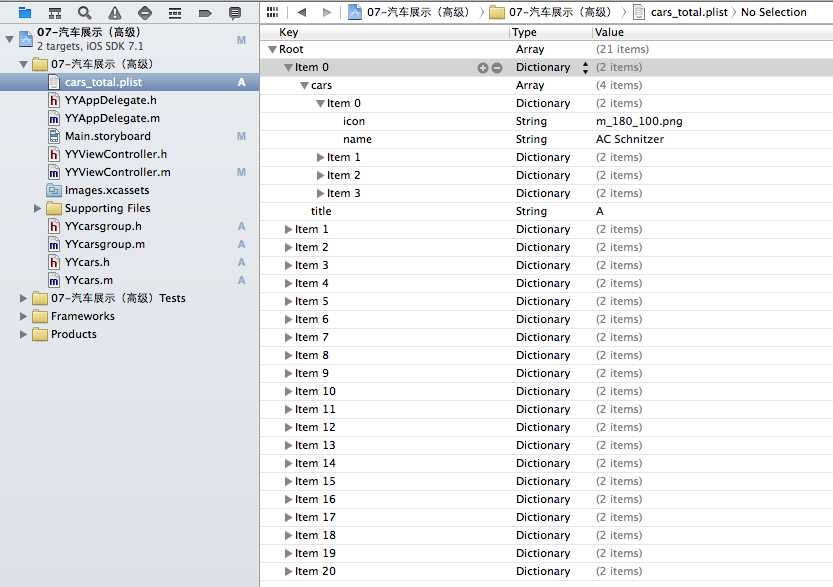标签:
plist :

模型Car
1 #import <Foundation/Foundation.h> 2 3 @interface CZCar : NSObject 4 5 /** 6 * 汽车名称 7 */ 8 @property (nonatomic,copy) NSString *name; 9 10 /** 11 * 汽车的图标 12 */ 13 @property (nonatomic,copy) NSString *icon; 14 15 //实现字典转模型的方法 16 // 对象方法 17 - (instancetype) initWithDict:(NSDictionary *) dict; 18 19 //类方法 20 + (instancetype) carWithDict:(NSDictionary *) dict; 21 22 23 @end 24 25 26 27 28 29 #import "CZCar.h" 30 31 @implementation CZCar 32 33 34 - (instancetype)initWithDict:(NSDictionary *)dict 35 { 36 if (self = [super init]) { 37 38 self.icon = dict[@"icon"]; 39 self.name = dict[@"name"]; 40 41 } 42 return self; 43 } 44 45 + (instancetype)carWithDict:(NSDictionary *)dict 46 { 47 return [[self alloc] initWithDict:dict]; 48 } 49 50 51 @end
模型CarGroup
1 #import <Foundation/Foundation.h> 2 3 @interface CZCarGroup : NSObject 4 5 //标题 6 @property (nonatomic,copy) NSString *title; 7 //汽车数组 8 @property (nonatomic,strong) NSArray *cars; 9 10 //提供两个字典转模型的方法 11 //对象方法 12 - (instancetype) initWithDict:(NSDictionary *) dict; 13 //类方法 14 + (instancetype) carGroupWithDict:(NSDictionary *) dict; 15 16 //加载plist文件,把字典数组转换为模型数组 17 + (NSArray *) carGroups; 18 19 20 21 @end 22 23 24 25 26 27 #import "CZCarGroup.h" 28 #import "CZCar.h" 29 30 @implementation CZCarGroup 31 32 - (instancetype)initWithDict:(NSDictionary *)dict 33 { 34 if (self = [super init]) { 35 self.title = dict[@"title"]; 36 self.cars = dict[@"cars"]; 37 } 38 return self; 39 } 40 41 42 + (instancetype)carGroupWithDict:(NSDictionary *)dict 43 { 44 return [[self alloc] initWithDict:dict]; 45 } 46 47 48 + (NSArray *)carGroups 49 { 50 // 1.加载plist 51 // 获取绝对路径 52 NSString *filePath = [[NSBundle mainBundle] pathForResource:@"cars_total" ofType:@"plist"]; 53 // 读取数组(分组的字典) 54 NSArray *array = [NSArray arrayWithContentsOfFile:filePath]; 55 56 // 2.把array中分组的字典转为模型 57 // 2.1 定义一个可变数组 58 NSMutableArray *arrayM = [NSMutableArray array]; 59 // 遍历array,把它里面存放的组字典转换为组模型,放到arrayM中 60 for (NSDictionary *dict in array) { 61 CZCarGroup *carGroup = [self carGroupWithDict:dict]; 62 // 这个字典数组 63 NSArray *dictArray = carGroup.cars; 64 // 把dictArray转换为一个CZCar的模型数组 65 66 // 定义一个可变数组用来存放转换后的CZCar模型 67 NSMutableArray *carsArray = [NSMutableArray array]; 68 // 遍历字典数组dictArray,把字典转换为CZCar的模型 69 for (NSDictionary *dict in dictArray) { 70 // 把字典转换为CZCar的模型 71 CZCar *car = [CZCar carWithDict:dict]; 72 // 把转换后的car添加到carsArray数组中 73 [carsArray addObject:car]; 74 } 75 // 把转换后的CZCar的模型数组赋值给carGroup的cars属性 76 carGroup.cars = carsArray; 77 78 [arrayM addObject:carGroup]; 79 } 80 // 3.返回组模型数组 81 return arrayM; 82 } 83 84 85 @end
控制器
#import "ViewController.h" #import "CZCarGroup.h" #import "CZCar.h" @interface ViewController () <UITableViewDataSource> //定义一个汽车分组的模型数组 @property (nonatomic,strong) NSArray *carGroups; @property (weak, nonatomic) IBOutlet UITableView *tableView; @end @implementation ViewController - (void)viewDidLoad { [super viewDidLoad]; // Do any additional setup after loading the view, typically from a nib. // 1.验证carGroups数组中存放什么东西 // NSLog(@"%@",self.carGroups); // 2.验证carGroup中的cars属性中存放是社么东西 // 取出第一个汽车分组 // CZCarGroup *carGroup = [self.carGroups firstObject]; //// 打印cars属性 // NSLog(@"%@",carGroup.cars); // 设置tableVeiw的数据源为控制器 self.tableView.dataSource = self; } #pragma mark - 实现数据源方法 //一共多少组 - (NSInteger) numberOfSectionsInTableView:(UITableView *)tableView { return self.carGroups.count; } //每一组多少行 - (NSInteger) tableView:(UITableView *)tableView numberOfRowsInSection:(NSInteger)section { // 1.取出分组对应的carGroup模型 CZCarGroup *carGroup = self.carGroups[section]; // 2.返回cars属性的长度 return carGroup.cars.count; } //每一行显示什么内容 - (UITableViewCell *) tableView:(UITableView *)tableView cellForRowAtIndexPath:(NSIndexPath *)indexPath { // 0.定义一个可重用的标示 NSString *reuseId = @"car"; // 1.去缓冲池中取可重用的cell UITableViewCell *cell = [tableView dequeueReusableCellWithIdentifier:reuseId]; // 2.如果缓冲池中没有,创建新的cell if (cell == nil) { cell = [[UITableViewCell alloc] initWithStyle:UITableViewCellStyleDefault reuseIdentifier:reuseId]; } // 3.设置数据 // 3.1 取出组模型 CZCarGroup *carGroup = self.carGroups[indexPath.section]; // 3.2 取出CZCar模型 CZCar *car = carGroup.cars[indexPath.row]; // 3.3 使用car给cell设置数据 // 设置图标 cell.imageView.image = [UIImage imageNamed:car.icon]; // 设置汽车名称 cell.textLabel.text = car.name; // 4.返回cell return cell; } // 头部标题 - (NSString *) tableView:(UITableView *)tableView titleForHeaderInSection:(NSInteger)section { // 1.取出组模型 CZCarGroup *carGroup = self.carGroups[section]; // 2.返回组模型的标题 return carGroup.title; } // 实现分组索引 - (NSArray *) sectionIndexTitlesForTableView:(UITableView *)tableView { // 存放标题 // NSMutableArray *arrayM = [NSMutableArray array]; //// 遍历carGroups,让把标题放入arrayM中 // for (CZCarGroup *carGroup in self.carGroups) { // [arrayM addObject:carGroup.title]; // //// [arrayM addObject:@"啊哈哈"]; // } // // return arrayM; return [self.carGroups valueForKey:@"title"]; } #pragma mark - 隐藏状态栏 // 询问状态栏要不要隐藏 - (BOOL)prefersStatusBarHidden { return YES; } #pragma mark - 懒加载数组 - (NSArray *)carGroups { if (_carGroups == nil) { _carGroups = [CZCarGroup carGroups]; } return _carGroups; } @end
标签:
原文地址:http://www.cnblogs.com/DoNib-Coding/p/4780813.html